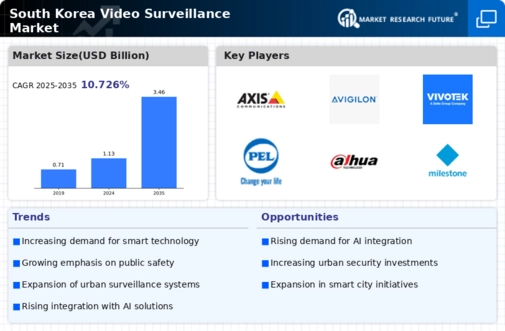The video surveillance market in South Korea is characterized by a dynamic competitive landscape, driven by technological advancements and increasing demand for security solutions across various sectors. Major players such as Hikvision (CN), Hanwha Techwin (KR), and Axis Communications (SE) are at the forefront, each adopting distinct strategies to enhance their market presence. Hikvision (CN) focuses on innovation, particularly in AI-driven analytics, which positions it as a leader in smart surveillance solutions. Meanwhile, Hanwha Techwin (KR) emphasizes regional expansion and partnerships, aiming to strengthen its foothold in the domestic market. Axis Communications (SE) is known for its commitment to sustainability and digital transformation, which resonates well with the growing emphasis on eco-friendly technologies in South Korea. Collectively, these strategies contribute to a competitive environment that is increasingly shaped by technological innovation and strategic collaborations.
Key business tactics within the market include localizing manufacturing and optimizing supply chains to enhance operational efficiency. The competitive structure appears moderately fragmented, with several key players vying for market share. This fragmentation allows for a diverse range of offerings, catering to various customer needs while also fostering innovation. The influence of major companies is significant, as they set industry standards and drive technological advancements that smaller players often follow.
In September 2025, Hikvision (CN) announced the launch of its latest AI-powered surveillance camera, which integrates advanced facial recognition capabilities. This strategic move is likely to enhance its competitive edge by addressing the increasing demand for sophisticated security solutions. The introduction of such technology not only reinforces Hikvision's position as an innovator but also aligns with the broader trend of integrating AI into surveillance systems, which is becoming a critical differentiator in the market.
In October 2025, Hanwha Techwin (KR) entered into a strategic partnership with a leading telecommunications provider to develop a next-generation cloud-based surveillance platform. This collaboration is indicative of Hanwha's commitment to digital transformation and positions it to leverage cloud technology for enhanced scalability and flexibility in its offerings. Such partnerships are essential in a market where technological integration is paramount, allowing Hanwha to stay competitive amidst evolving customer expectations.
In August 2025, Axis Communications (SE) unveiled its new line of environmentally friendly surveillance products, which utilize sustainable materials and energy-efficient technologies. This initiative not only reflects Axis's dedication to sustainability but also caters to the increasing consumer preference for eco-conscious products. By prioritizing sustainability, Axis is likely to attract a broader customer base, particularly among organizations that value corporate social responsibility.
As of November 2025, current trends in the video surveillance market are heavily influenced by digitalization, sustainability, and the integration of AI technologies. Strategic alliances are increasingly shaping the competitive landscape, enabling companies to pool resources and expertise to innovate more effectively. Looking ahead, competitive differentiation is expected to evolve, with a notable shift from price-based competition to a focus on innovation, advanced technology, and supply chain reliability. This transition suggests that companies that prioritize these aspects will likely emerge as leaders in the market.



















Leave a Comment